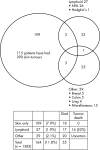Lymphoproliferative disorders in Oxford renal transplant recipients
- PMID: 12783971
- PMCID: PMC1769976
- DOI: 10.1136/jcp.56.6.439
Lymphoproliferative disorders in Oxford renal transplant recipients
Abstract
Background: Increased cancer incidence, particularly lymphoproliferative disease, is a complication of immunosuppression in organ transplantation. Non-Hodgkin's lymphomas (NHLs) occur frequently during the first year after transplantation, more so in North America than in Europe.
Methods: This study audited and correlated the demographic, clinical, pathological, and outcome features of post-transplant lymphoproliferative disorders (PTLDs) in a large centre in Oxford, and assessed whether the time of onset fitted more with the European or North American pattern.
Results: There were 1383 renal transplants in the study period and 27 patients developed lymphoma: 26 NHLs and one Hodgkin's disease (1.95%). Four of the patients never received cyclosporin. The mean time of diagnosis after transplant was 46 months. Most tumours (21/27) presented extranodally. Management included reduction of immunosuppression, surgical excision, antiviral treatment, radiotherapy, and chemotherapy. Three patients presented in the first post-transplant year-0.34% of cyclosporin managed patients-similar to the North American incidence, although the incidence of extranodal late PTLDs was also high (mean onset, 36 months v 15 months international mean). Post-transplant lymphomas were the most common malignancy associated with death in transplant patients.
Conclusions: PTLDs occurred in 2% of renal transplant patients, presenting both in the first year in association with cyclosporin use, as in North America, but also in subsequent years, giving an overall presentation time later than the international mean. The disease usually presented extranodally, accounting for the wide range of symptoms and signs. Despite awareness and active management, the disease contributed to death in more that 50% of patients with PTLDs.
Figures
Similar articles
-
Post-transplant lymphoproliferative disorders after live donor renal transplantation.Clin Transplant. 2005 Oct;19(5):668-73. doi: 10.1111/j.1399-0012.2005.00406.x. Clin Transplant. 2005. PMID: 16146560
-
Post-transplant lymphoproliferative disorders: improved outcome after clinico-pathologically tailored treatment.Haematologica. 2002 Jan;87(1):67-77. Haematologica. 2002. PMID: 11801467
-
Durable remission after aggressive chemotherapy for very late post-kidney transplant lymphoproliferation: A report of 16 cases observed in a single center.J Clin Oncol. 2000 Nov 1;18(21):3622-32. doi: 10.1200/JCO.2000.18.21.3622. J Clin Oncol. 2000. PMID: 11054435
-
Late onset post transplantation lymphoproliferative disorders: analysis of international data from 5 studies.Ann Transplant. 2009 Oct-Dec;14(4):80-5. Ann Transplant. 2009. PMID: 20009160 Review.
-
Basiliximab: a review of its use as induction therapy in renal transplantation.Drugs. 2003;63(24):2803-35. doi: 10.2165/00003495-200363240-00009. Drugs. 2003. PMID: 14664658 Review.
Cited by
-
Lymphoma after living donor kidney transplantation: an Iranian multicenter experience.Int Urol Nephrol. 2008;40(4):1089-94. doi: 10.1007/s11255-008-9377-0. Epub 2008 Jul 1. Int Urol Nephrol. 2008. PMID: 18592392
-
Pathobiology and treatment of lymphomatoid granulomatosis, a rare EBV-driven disorder.Blood. 2020 Apr 16;135(16):1344-1352. doi: 10.1182/blood.2019000933. Blood. 2020. PMID: 32107539 Free PMC article. Review.
-
Spectrum of lymphoproliferative disorders following renal transplantation in North India.Indian J Nephrol. 2013 Jul;23(4):287-91. doi: 10.4103/0971-4065.114504. Indian J Nephrol. 2013. PMID: 23960346 Free PMC article.
-
Cigarette Smoking and Its Hazards in Kidney Transplantation.Adv Med. 2017;2017:6213814. doi: 10.1155/2017/6213814. Epub 2017 Jul 27. Adv Med. 2017. PMID: 28819637 Free PMC article. Review.
-
Recurrent lymphomatoid papulosis associated with nephrotic syndrome. An occurrence of uncertain origin.Pediatr Nephrol. 2009 Jan;24(1):189-92. doi: 10.1007/s00467-007-0667-z. Epub 2007 Nov 20. Pediatr Nephrol. 2009. PMID: 18026996
References
-
- Opelz G, Henderson R. Incidence of non-Hodgkin lymphoma in kidney and heart transplant recipients. Lancet 1993;342:1514–16. - PubMed
-
- Harris NL, Ferry JA, Swerdlow SH. Posttransplant lymphoproliferative disorders: summary of Society for Hematopathology workshop. Semin Diagn Pathol 1997;14:8–14. - PubMed
-
- Liddington M, Richardson AJ, Higgins RM, et al. Skin cancer in renal transplant recipients. Br J Surg 1989;76:1002–5. - PubMed
MeSH terms
Substances
LinkOut - more resources
Full Text Sources
Medical


